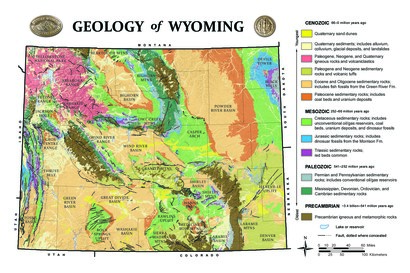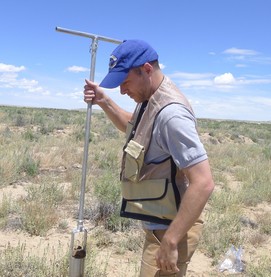|
Heavy-mineral-sand placer deposits are the world’s primary source for titanium and zirconium. In Wyoming, Cretaceous-age heavy-mineral sands are also a potential source for rare earth elements, hafnium, niobium, and vanadium.
The elements mentioned above are critical mineral commodities, which are essential to the economic and national security of the United States. The U.S. Department of Interior in 2018 created a list of 35 such mineral commodities.
For this project, Wyoming State Geological Survey (WSGS) geologist Derek Lichtner is assessing critical mineral potential of heavy-mineral sand deposits in the Upper Cretaceous Rock Springs Formation in Sweetwater County. His study combines ore-grade analyses and geologic reconstruction.
The goal is to provide geochemical analyses, including bulk rock, trace element, and rare earth element analyses; petrographic analysis of ore mineralogy and provenance; and predictive framework for critical mineral potential in the Rock Springs Formation.
The project could be the first of many for Cretaceous heavy-mineral sand ore deposits in Wyoming. Future work may focus on the Mesaverde Formation in the Bighorn Basin, Fox Hills Sandstone in the Powder River Basin, and Frontier Formation in southwest Wyoming.
Geologist Derek Lichtner examines a dark maroon-colored heavy-mineral sand paleoplacer in the Rock Springs Formation near Bradley Road, southeast of Rock Springs. Unlike most sandstones, which are composed mostly of quartz, these paleoplacer deposits are enriched in dense, dark-colored minerals that contain titanium, zirconium, rare earth elements, and other trace elements. During the late Cretaceous the waves and currents of the Western Interior Seaway concentrated the "heavy" minerals in this ancient beach deposit.
A new WSGS postcard depicting the general geology of Wyoming is available. The 4-inch-by-6-inch card includes a colorful map of rock formations, faults, basins, mountain ranges, and other geologic features throughout the state.
The geologic map is modified from the Geologic Map of Wyoming, first published in 1985 by J.D. Love and A.C. Christiansen, and shows map units as young as active modern sand dunes to igneous and metamorphic rocks more than 3.4 billion years old. The map explanation points out rock units that are important to Wyoming’s economic geology and also highlights certain units that contain fossils.
The new postcard is available online and at the WSGS office on the University of Wyoming campus in Laramie.

The Greater Green River Basin (GGRB) in southwestern Wyoming produced 62 percent of Wyoming natural gas in 2019. That same year, the basin was responsible for 13 percent of the state’s oil. Although nearly all modern production in the region is conventional, the source rocks for these conventional systems, including the Lewis Shale, Hilliard-Baxter-Mancos, Niobrara, and Phosphoria formations, are high-priority petroleum systems that may have potential as continuous reservoirs.
The WSGS is collecting and interpreting baseline geologic data from the Wyoming portion of the Southwestern Wyoming Province petroleum system, or GGRB. This updated assessment includes location, formation top and thickness, initial API gravity, initial production, initial gas/oil ratio, and bottom-hole or maximum recorded temperature from oil and gas wells in the GGRB. Additional useful data collected include gas analyses, total organic carbon, and producing intervals.
The data will be added to the Survey’s spatial subsurface energy database, which incorporates similar datasets derived from other basins across Wyoming, as previously funded by the U.S. Geological Survey National Coal Resources Data System Unconventional Oil and Gas program. This work complements the in-production WSGS digital depth-to-Precambrian basement map by expanding the subsurface dataset from the basement to the surface using data from existing oil and gas wells.

The WSGS assisted the U.S. Bureau of Reclamation this summer on an investigation of the South Granite Mountains Fault system in the Seminoe and Ferris mountains. Trenches were excavated to identify and measure recent offset along the fault system. The goal of the multi-year study is to determine the local earthquake hazard of the poorly understood South Granite Mountains Fault System.
Two trenches, 70 and 100 meters long, were dug 10 miles apart on the northern flank of the Seminoe Mountains. In addition, a third trench, roughly 50 meters long, was excavated across the Ferris Mountains segment of the South Granite Mountains Fault system, near Pete Creek. Bedrock and unconsolidated materials were found in the trenches, hinting at Quaternary (<2.6 million years) events recorded in the trench.
Geologists spent months examining the exposed earth in the trenches, recording unconformities, offsets, fissures, and other evidence of recent surface rupturing earthquakes. Ghost clasts, offset bedding planes, fissure fills, and changes in soil helped tell the area’s geologic story.
|
 |

A series recognizing staff and their contributions
Jim Stafford—Project Geohydrologist who focuses on resource analysis, modeling, GIS, and online maps at the WSGS, 15 years of service
What do you do at the WSGS: My specialty is acquiring and creating large databases of resource information, processing and organizing it, and using it in spatial and/or temporal models that I create. I use the analytical products of the models to make maps, figures, and graphs showing the results. I conduct hydrologic and geologic research on a variety of topics and work with team members to write and edit reports. Over the last 5 years I have also been using my GIS skills to make and maintain a number of interactive online maps, which are a great dynamic way to display analytical results of our projects. I have a lot of experience with Wyoming geology, and digitize and compile geologic maps some years.
What makes your job interesting: Primarily I love science! Always being able to learn new things about the Earth and our state is great. I have always loved maps and I get to spend a lot of time making them. I really enjoy the challenge of solving complex data processing puzzles. The variety of work I do keeps it fun and interesting.
How does your job help Wyoming: There is a tremendous amount of raw data out there. I help make it into useful decision-making tools for our state. Every time a road is built or a wind turbine is sited, a geologic map is consulted. When a natural gas play is permitted or a mine is planned, our aquifer reports are used. I get to be part of the team that primes the pump of geologic knowledge, which runs the engine of Wyoming's responsible resource development.
What are some of your favorite geologic features in the state: As a life-long Wyomingite, I am very biased! There is something I find fascinating in every part of the state. Having a background in water, I especially like the hydrogeologic oddities like Periodic Spring, Sinks Canyon, Anchor Reservoir, and Devil's Gate. Underrated is maybe the Pathfinder Dam area. It has a lot of neat history and geology, and when the reservoir is overtopping, it's one of the best waterfalls you will ever see.
|
|